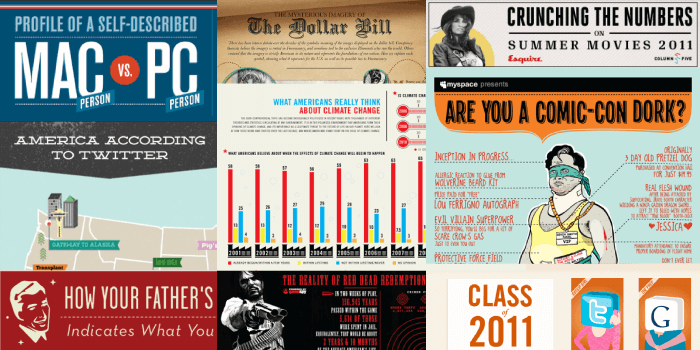The use of infographics has grown significantly over the past few years. Today, they are used to both inform and engage audiences in many different industries and settings. There are still a few areas, however, where there is a great opportunity to improve and transform communication through information design. Wondering how you can use infographics across your organization?
 5 Underutilized Applications for Infographics
5 Underutilized Applications for Infographics
From client relations to presentations, here are the clever ways infographics can help you communicate more effectively.
1) Agency-Client Reporting
There are inherent challenges for agencies reporting achievements to their clients. Unless clear metrics have been defined to measure success, clients can have a difficult time interpreting and understanding results. This increases the likelihood of a client getting caught up in unimportant details or glossing over important numbers. The future of the relationship hinges on an agency’s ability to communicate its value in a clear and concise way. It is essential to highlight key figures, and make sure relationships are not only explained but also visualized.
Presenting your results using an infographic is an effective way to do this, as good information design highlights important trends and minimizes less important details. This allows agencies to showcase successes and keep their clients clear and informed on the great work that is being done for them.
2) Trade Shows
Trade shows can be a chaotic place, filling large convention centers with rows of vendors, designers, and industry insiders. Oftentimes, everything presented is reduced to pure noise and nothing stands out. Great ideas get intermingled with bad ones, receiving very little attention, and, even worse, bad ideas can get picked up as good ones.
Interactive data visualization can help solve this problem by providing a dynamic experience for attendees. Polls can be held, and social media sites can be crawled for mentions with results displayed at the convention in real-time, showing ideas, interactions, and sentiment that will keep viewers interested and engaged.
3) Live-Action Video Infographics
Most video and motion graphics today are based on illustration, which is a great way to visualize an abstract idea. What is thus far underutilized, however, is the use of graphics with live-action video.
Live-action footage overlaid with statistics, graphics and other information has the potential to bring people closer to an issue by visually relating to real-world imagery. To see the financial impact of a construction project, or the country of origin for everyday products, for example, would leave a lasting impression when viewed in the context of the actual environment.
4) Direct Mail
There may not be a more disregarded and ignored piece of content than direct mail. It gets lost easily among bills and other advertisements. Nobody likes it, which is why it is ripe for a re-boot.
We recently created an infographic for Harvard Law School that outlined the demographics of the student body and their achievement level. It was not only posted online but also mailed out to prospective students. The result was an eye-catching and informative graphic that wasn’t just lost in the pile.
5) Visual Abstracts
White papers are a great way to establish thought leadership in your field. Done well, it’s an easy and effective way to set yourself apart from your competitors. Getting your white papers read, on the other hand, isn’t so easy.
Garnering interest in your 50-page research document is a difficult task without a visually appealing lead-in. Using an infographic to summarize the most important information in your white paper upfront is a great way to get people excited about some of the key findings, enticing them to dive into the rest of your work.
Infographics are widely used today, but there are still many areas of opportunity for their application. Wherever concise and engaging communication is necessary, good information design will always be able to help.
How to Create Infographics
If you’re ready to put infographics to use in your organization, make sure you follow best practices from the jump.
- Find out how to brainstorm good infographic ideas.
- See our guide to create infographics from scratch.
- Get inspired by these great examples of infographics.
And if you need any help creating those awesome infographics, find out what to look for in a creative agency, or hit us up.





